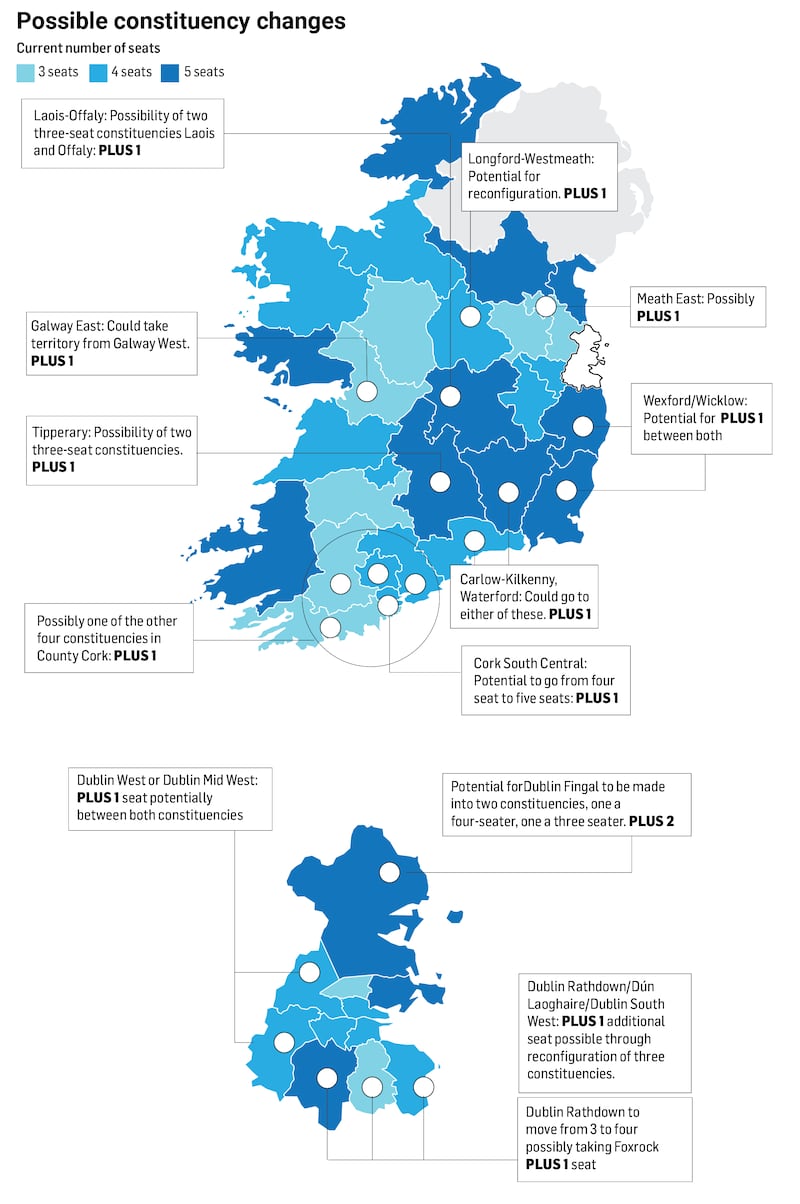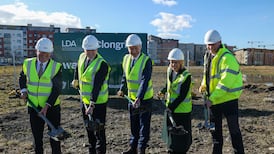How do you solve a problem like Drogheda and east Meath? It is perhaps one of the trickiest issues the Electoral Commission will have been grappling with as it conducts its review of Dáil constituencies, a final report on which is due out this week.
Drogheda — which is technically the largest town in Ireland, with some campaigning for it to be granted city status — has a population of 44,135, with plans for housing for at least another 20,000 people in the near future. While it is mostly in Co Louth, the town’s southern fringes also cross the border into Co Meath.
Meanwhile, the Co Meath coastal communities of Bettystown, Laytown, Mornington and Julianstown have a combined population of 27,912. They too vote in the current Louth constituency, despite living in a different county.
[ Meath East: Full Election 2020 results breakdown, story of the count and profilesOpens in new window ]
[ Louth: Full Election 2020 results breakdown, story of the count and profilesOpens in new window ]

Crime on the public's mind, politicians brace for constituency reform
There are overlapping issues in both areas — which form part of Dublin’s commuter belt — such as the huge growth in population and the need to play catch-up with the provision of housing, infrastructure, public transport and amenities. However, there is a sense that many residents in eastern Meath who have been voting in the Louth constituency for several years feel somewhat disenfranchised.
This is not helped by the fact that all of their current TDs are from the other side of the county border.
The terms of the commission’s deliberations say that “the breaching of county boundaries shall be avoided as far as practicable” but this can be difficult in a place like Drogheda.
The current Louth constituency has five seats while Meath East has three.
Under the Constitution, there must be one TD for every 20,000 to 30,000 people. The combined population of Louth and Meath East is 265,674 so a possible simple solution would be to create two five-seat constituencies — Louth and an expanded Meath East whose population would justify the numbers if the coastal areas were returned to it.
But there are complicating factors such as housing estates in Drogheda being split across two counties and the practical ways that people in its Co Meath hinterland interact with their nearest big town.
Public submissions to the commission’s review show how a series of contributors from Drogheda believe the town and its surrounding area should all remain in the same constituency. Equally, submissions from Co Meath express a desire for the coastal communities to be reunited with the rest of the county in the same Dáil constituency.
The Drogheda City Status Group argues that the Louth-Meath border is “an obsolete device which hinders both community and economic development”. It suggests there could be two three-seat constituencies in Louth — one in the north where Dundalk would be the major urban centre — and the other including Drogheda and eastern parts of Meath to be known as “Greater Drogheda”, “Louth South” or “Boyneside”.

In his submission to the commission, Hubert Murphy, president of the Drogheda & District Chamber, said the town has “suffered for quite some time due to its location on the boundary of two counties”.
He said the chamber was asking that the ability to govern Drogheda in a coherent way, “is not undermined by splitting the settlement between two constituencies”.
Mr Murphy, who is also the general manager of Drogheda United FC, told The Irish Times there must be a “people first ethos” when it comes to the provision of services and infrastructure and having two different constituencies in the same town would be “terrible”.
He suggested that the commission’s decision will “probably be contentious in many ways with people who have their own ideas for how it could go … It’s certainly going to be eagerly awaited.”
Fine Gael TD for Louth Fergus O’Dowd said there is “an awful lot of interaction, social, schools, shopping that goes on between East Meath and Drogheda ... There’s huge bonds between them.”
He acknowledged that “the Meath jersey is very strong” the further into the county you go.
“I would like to see a reasonable amount of Drogheda’s hinterland being in a constituency with the rest of Drogheda,” said Mr O’Dowd, adding that it was not his call and he was leaving it up to the commission as to where the line would be drawn.
On the other side of the border, Fianna Fáil’s organisation in Meath East — where the party’s local TD is Minister of State Thomas Byrne — has highlighted how parts of Meath are in the Cavan-Monaghan and Louth constituencies. “We respectfully request that you reverse this decision and re-unite county Meath,” it asked the commission.
A submission from a member of Bettystown Tidy Towns said the current arrangements “hamper us getting services in our area ... We live in east Meath and should be in the East Meath constituency.”
Keith Loughman, chairman of St Colmcille’s GAA club in Bettystown, told the commision there is a “mismatch” between local needs being served “excellently” by Meath County Council and its national political representation being in Louth. He suggested some issues are “falling between two stools” and asked that the parts of Co Meath in the Louth constituency be returned to Meath East.
Sharon Tolan, a Bettystown-based councillor for Fine Gael, said the need for affordable housing and coastal protection from flooding are the biggest issues locally.
Of the current constituency set-up, she said “people are very much loyal to their counties”.
She said there has sometimes been a lower turnout for general electionsin the coastal parts of Meath than for referendums and local elections and argued it is “very clear” that people there “don’t seem to relate to Louth candidates”.
Ms Tolan hopes to become a candidate for Fine Gael in the next general election but will not know which constituency she will be seeking to run in until the commission reports.
Asked if she would prefer it to be a newly expanded Meath East constituency, she replies: “They do say all politics is local and it is true — people want to be able to see their local TD working on the ground.”
But she would be “happy to run absolutely anywhere ... as long as I was representing the people here in east Meath”.
Meath East Sinn Féin TD Darren O’Rourke said he would like to see the east coast areas returned to the rest of Meath in part because the current arrangement creates confusion for people in terms of who their local representatives are.
He says there is also consistency between the issues that arise in places on the east coast — like the growing population since the Celtic Tiger boom and the need to retrospectively provide amenities and services — and concerns of people in inland towns like Ashbourne and Rathoath which are part of the Meath East constituency.
Mr O’Rourke also said he could see why politicians in Louth might want to keep the coastal parts of Meath in their constituency. “Nobody — none of the sitting TDs ... or anyone looking to be TD — is likely to say, “we want to carve off votes in east Meath because what happens if they don’t carve them off?”
How to divvy up Dáil seats between two counties on the east coast is just one of a number of tough calls the commission will have to make countrywide, but it is a big one. It will shape how more than a quarter of a million people are represented in the Dáil for at least five years after the next general election and perhaps much longer.
Constituency: Meath East
Current number of seats: Three
Sitting TDs: Thomas Byrne (FF), Helen McEntee (FG), Darren O’Rourke (SF)
Population Census 2016: 87,169
Population Census 2022: 98,662 (+13.2 per cent)
Population per Dáil member 2022: 32,887
Lay of the land: Meath East includes towns like Ashbourne, Dunboyne, Slane, and Kells and a sliver of Co Meath’s coastline at Gormanston.
Options: Shifting places like Bettystown, Laytown and Julianstown — in the Louth constituency — to Meath East and returning parts of the county that were moved to Cavan-Monaghan would easily justify the creation of a five-seat constituency. Alternatively, there have been suggestions that a new Drogheda-Meath East constituency comprising the Co Louth town and coastal parts of Co Meath could become a stand-alone three-seater. The rest of Meath East would still have enough people to be a four-seater. Another option would be to return the coastal areas to Meath East and, with an internal redraw in the county, create two four-seaters — Meath East and Meath West.
Constituency: Louth
[ Louth: Full Election 2020 results breakdown, story of the count and profilesOpens in new window ]
Current number of seats: Five
Sitting TDs: Peter Fitzpatrick (Ind), Imelda Munster (SF), Ged Nash (Lab), Fergus O’Dowd (FG), Ruairi Ó Murchú (SF).
Population Census 2016: 150,924
Population Census 2022: 167,012 (+10.7 per cent)
Population per Dáil member 2022: 33,402
Lay of the land: The Louth constituency comprises two major population centres — Drogheda in the south and Dundalk in the north. The town of Drogheda is tricky as some of its estates are located on both sides of the Louth-Meath border and its southern hinterland is in Co Meath. The constituency includes a coastal part of east Meath including Bettystown, Laytown and Mornington which has a population of almost 27,912.
Options: The parameters of the constituency review do not allow for six seats so there will be change. If the parts of Co Meath that are in the constituency were hived off, Louth has enough people in its own right to remain a five-seater. There’s also the possibility of a north-south split while retaining the coastal parts of Meath to create two three-seaters.
















